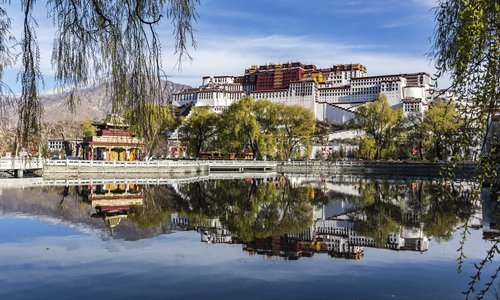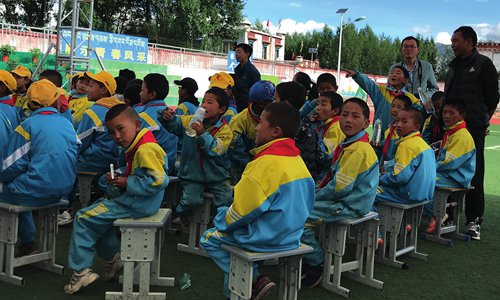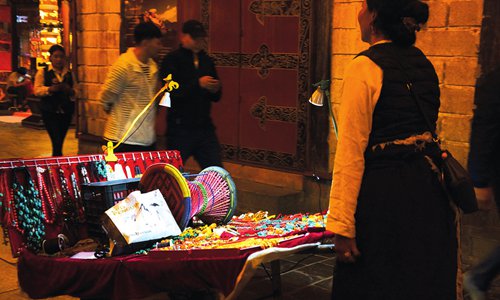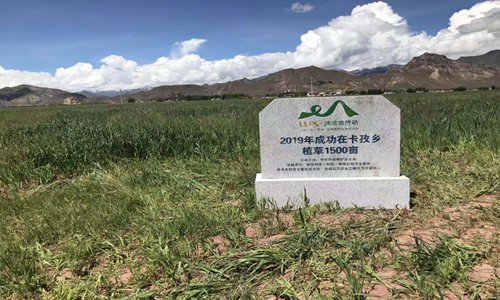HOME >> BUSINESS
Grassland cultivation combats poverty and soil degradation in Tibet
By Yang Kunyi Source:Global Times Published: 2019/9/16 17:53:39

Potala Palace in Lhasa, Tibet Autonomous Region Photo: VCG

Students in Karze Township, Tibet Autonomous Region, attend a grassland cultivation celebration. Photo: Yang Kunyi/GT

A vendor sells her handicraft wares near Jokhang Temple, Tibet Autonomous Region. Photo: Yang Kunyi/GT

The grassland cultivation project Go Green Go Lux has grown a total of 1,500 mu of grassland in Katze county, Southwest China's Tibet Autonomous Region in 2019. Photo: Courtesy of Lux
Situated on the Tibetan plateau, Southwest China's Tibet Autonomous Region has long been facing pressure from extreme weather conditions and soil degradation due to overgrazing by livestock. Over the past decade, however, the region has witnessed significant improvement when it comes to both the local ecosystem and people's livelihoods thanks to collaborative projects involving local authorities, cooperatives and corporations.
Reversing soil degradation
Grassland cultivation is one of the major pioneering areas that aim to combat these challenges in Tibet.
Over the years, projects in this field have helped maintain a balance between development and environmental protection. Progress has been significant, desertification in Tibet has been reduced by 13,600 hectares since 2018, while 35,000 hectares of sandy land has been reclaimed since 2009, according to the Ministry of Forestry and Grasslands in Tibet.
The reason that so much effort has been dedicated to grassland cultivation is because it serves as an important part of the terrestrial ecosystem and plays an essential role in water conservation and forage productivity on the Qinghai-Tibet Plateau, Rohit Jawa, president of Unilever North Asia, told the Global Times.
This year marks the ninth year of Unilever's Go Green Go Lux campaign, one of the major corporate charity programs in Tibet that aims to not only combat desertification through cultivating grasslands, but also benefit the economy of local communities.
"It was very fortunate that we started the Go Green Go Lux program," Jawa said.
"Over the past nine years, what started as a small initiative has become quite large as a total of 2,000 hectares of grasslands have been planted."
Wu Junxi is just one of the environment experts from the Chinese Academy of Sciences that has been working with Unilever on grassland cultivation over the past 10 years. For the past decade, he has spent at least six months of the year coming up with cultivation plans that can both ease the pressure on natural grasslands from grazing, and bring more commercial benefits to local farmers.
"In Konggar county alone, the project has cultivated a 66 hectares of grasslands as of today," Wu told the Global Times.
"The cultivated grass can help the local farmers and herdsmen through the winter and sometimes offer additional income through sales of grass. But more importantly, the project has also improved the local environment by reversing soil erosion. So in the long term, it provides a more sustainable way of living for local farmers and herdsmen."
Lifted from poverty
Konggar is a great example of how grassland cultivation goes beyond protecting local environment.
"We started as a corporate environmental program, but then we realized that raising cattle was one of the major sources of income for local farmers, so the project began helping alleviate local poverty through various ways," Ma Wen, vice president of Beauty & Personal Care Categories for Unilever North Asia, told the Global Times.
The Tibetan economy relies heavily on its agriculture, notably livestock raising. According to a report by the Regiona l Bureau of Statistics in Tibet, in the first half of 2019, the primary industry's added value reached 4.36 billion yuan ($616.59 million), a year-on-year increase of 3.7 percent, while the total GDP in Tibet in the first half of 2019 reached 68.2 billion yuan.
The agricultural sector has also been a highlight when it comes to creating local jobs, according to a report by the local statistics bureau.
In Karze Township in Tibet's Lhunzhub county, a grassland cultivation project has been going on for nine years, bringing tangible benefits to the local community.
"Without the poverty alleviation scheme provided by the local cooperative and corporations, a lot of people would be out of a job," Pazang Dolkar, the Party secretary of Bailang village in Karze Township, told the Global Times in a recent interview.
"In our village cooperative there are around 30 disabled people, and they are making a decent living by making small handicrafts."
Dolkar pointed out that a total of 158 households in the village have benefited from the increase in grasslands this year.
He added that grass cultivation, which is mostly done through cooperation between local government, corporations and experts like Wu, is bringing in over 100,000 yuan to 200,000 yuan annually to the villagers, a substantial addition to the relatively low local income.
According to Dolkar, programs like this are especially helpful for those residents that were living in extreme poverty in the most remote areas.
The projects help local farmers plan their grazing and grassland cultivation, and help them raise animals like sheep to provide additional income.
The cooperative in Bailang currently has more than 300 sheep that produce wool.
"There were a few households living up in the mountains with very poor transportation and they couldn't make a living," Dolkar said.
"Over the years, these households were relocated to Bailang village and started to grow grass and raise cattle. Last year on average each household got around 3,000 yuan from growing grass, in addition to their normal revenue from raising cattle."
Future e-commerce model
For the future, villages in Tibet like Bailang are exploring the potential of developing small local businesses with cooperatives and with the help of government and corporate poverty alleviation schemes alike.
According to Wang, apart from providing direct feed for the local herdsmen's cattle, the grassland cultivation program also plans to teach local farmers to explore possibilities in selling products from the local grasslands and building logistic centers to offer e-commerce channels for locals.
"For example, as a brand we highly focus on the fragrance of our products, and we are producing fragrance essence from the seeds of locally grown grass, which can be developed into a local product," Wang said, adding that logistics centers with e-commerce giants such as JD.com are already under development.
"In the future we hope we can build a new supply chain for local communities and develop a sustainable development model," Wang said.
Newspaper headline: Herding a happy life